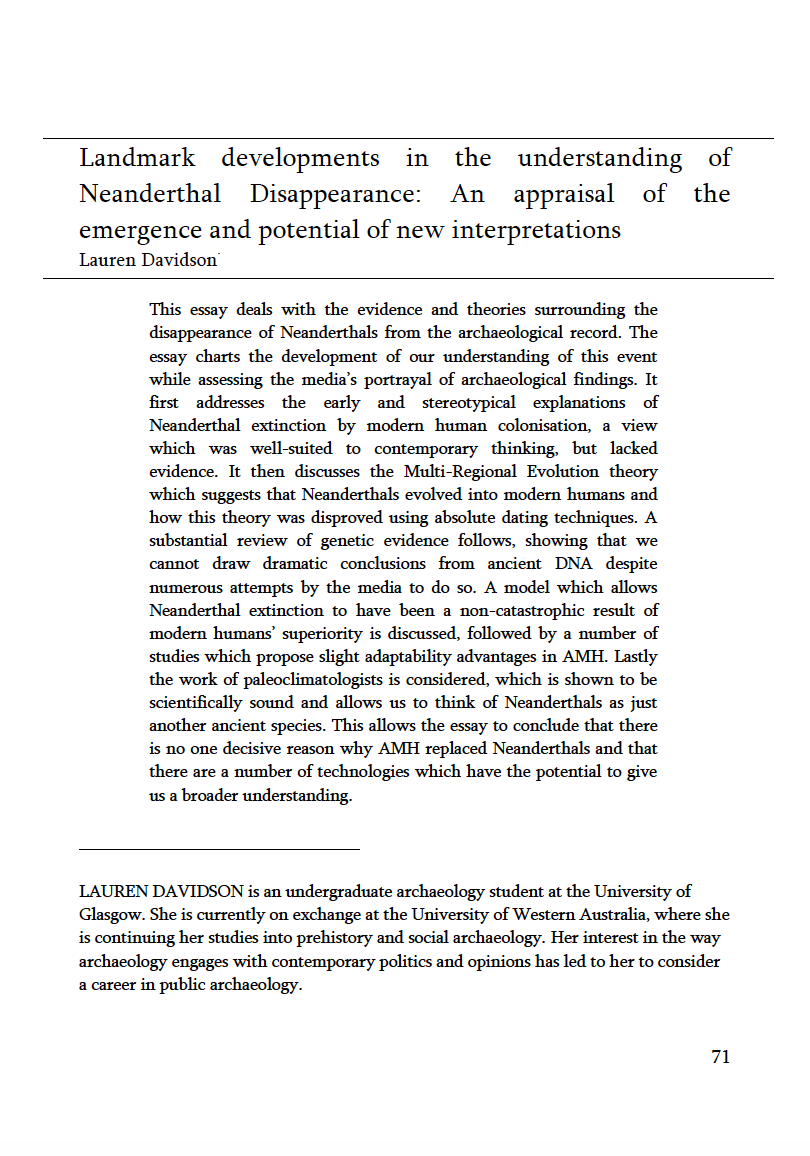Landmark developments in the understanding of Neanderthal Disappearance
An appraisal of the emergence and potential of new interpretations
DOI:
https://doi.org/10.36399/GroundingsUG.5.239Keywords:
Neanderthal, AMH, Archaeology, Multi-regional Evolution, DNA, Paleoclimatology, Critical Assessment, Neanderthal DisappearanceAbstract
This essay deals with the evidence and theories surrounding the disappearance of Neanderthals from the archaeological record. The essay charts the development of our understanding of this event while assessing the media’s portrayal of archaeological findings. It first addresses the early and stereotypical explanations of Neanderthal extinction by modern human colonisation, a view which was well-suited to contemporary thinking, but lacked evidence. It then discusses the Multi-Regional Evolution theory which suggests that Neanderthals evolved into modern humans and how this theory was disproved using absolute dating techniques. A substantial review of genetic evidence follows, showing that we cannot draw dramatic conclusions from ancient DNA despite numerous attempts by the media to do so. A model which allows Neanderthal extinction to have been a non-catastrophic result of modern humans’ superiority is discussed, followed by a number of studies which propose slight adaptability advantages in AMH. Lastly the work of paleoclimatologists is considered, which is shown to be scientifically sound and allows us to think of Neanderthals as just another ancient species. This allows the essay to conclude that there is no one decisive reason why AMH replaced Neanderthals and that there are a number of technologies which have the potential to give us a broader understanding.

Downloads
Published
Issue
Section
License
Copyright (c) 2012 Lauren Davidson

This work is licensed under a Creative Commons Attribution 4.0 International License.
The CC BY 4.0 license is a Creative Commons license. This is a non-copyleft free license that is good for art and entertainment works, and educational works. It is compatible with all versions of the GNU GPL; however, like all CC licenses, it should not be used on software. People are free to: Share — copy and redistribute the material in any medium or format; Adapt — remix, transform, and build upon the material for any purpose, even commercially. The licensor cannot revoke these freedoms as long as you follow the license terms. But they must conform to the following terms: Attribution — You must give appropriate credit, provide a link to the license, and indicate if changes were made. You may do so in any reasonable manner, but not in any way that suggests the licensor endorses you or your use. No additional restrictions — You may not apply legal terms or technological measures that legally restrict others from doing anything the license permits.
Please check individual article PDF copies to see if any additional restrictions apply.







